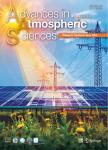Study on Quantitative Precipitation Estimation by Polarimetric Radar Using Deep Learning
作者机构:State Key Lab of Severe WeatherChinese Academy of Meteorological SciencesBeijing 100081China Meteorological observatory of Jiangxi ProvinceNanchang 330096China Hebei Meteorological Disaster Prevention and Environmental Meteorological CenterShijiazhuang 050021China School of Atmospheric SciencesChengdu University of Information TechnologyChengdu 610225China
出 版 物:《Advances in Atmospheric Sciences》 (大气科学进展(英文版))
年 卷 期:2024年第41卷第6期
页 面:1147-1160页
核心收录:
学科分类:0809[工学-电子科学与技术(可授工学、理学学位)] 08[工学] 0706[理学-大气科学]
基 金:supported by National Key R&D Program of China(Grant No.2022YFC3003903) the S&T Program of Hebei(Grant No.19275408D),the Key-Area Research and Development Program of Guangdong Province(Grant No.2020B1111200001) the Key Project of Monitoring,Early Warning and Prevention of Major Natural Disasters of China(Grant No.2019YFC1510304) the Joint Fund of Key Laboratory of Atmosphere Sounding,CMA,and the Research Centre on Meteorological Observation Engineering Technology,CMA(Grant No.U2021Z05).
主 题:polarimetric radar quantitative precipitation estimation deep learning single-parameter network multi-parameter network
摘 要:Accurate radar quantitative precipitation estimation(QPE)plays an essential role in disaster prevention and mitigation.In this paper,two deep learning-based QPE networks including a single-parameter network and a multi-parameter network are designed.Meanwhile,a self-defined loss function(SLF)is proposed during modeling.The dataset includes Shijiazhuang S-band dual polarimetric radar(CINRAD/SAD)data and rain gauge data within the radar’s 100-km detection range during the flood season of 2021 in North China.Considering that the specific propagation phase shift(KDP)has a roughly linear relationship with the precipitation intensity,KDP is set to 0.5°km^(-1 )as a threshold value to divide all the rain data(AR)into a heavy rain(HR)and light rain(LR)dataset.Subsequently,12 deep learning-based QPE models are trained according to the input radar parameters,the precipitation datasets,and whether an SLF was adopted,respectively.The results suggest that the effects of QPE after distinguishing rainfall intensity are better than those without distinguishing,and the effects of using SLF are better than those that used MSE as a loss function.A Z-R relationship and a ZH-KDP-R synthesis method are compared with deep learning-based QPE.The mean relative errors(MRE)of AR models using SLF are improved by 61.90%,51.21%,and 56.34%compared with the Z-R relational method,and by 38.63%,42.55%,and 47.49%compared with the synthesis method.Finally,the models are further evaluated in three precipitation processes,which manifest that the deep learning-based models have significant advantages over the traditional empirical formula methods.



